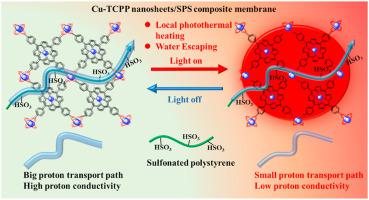当前位置:
X-MOL 学术
›
J. Membr. Sci.
›
论文详情
Our official English website, www.x-mol.net, welcomes your
feedback! (Note: you will need to create a separate account there.)
Photothermal responsive ultrathin Cu-TCPP nanosheets/sulfonated polystyrene nanocomposite photo-switch proton conducting membranes
Journal of Membrane Science ( IF 8.4 ) Pub Date : 2021-02-01 , DOI: 10.1016/j.memsci.2020.118888 Shabab Hussain , Zheng Deng , Amin Khan , Peipei Li , Zhuoyi Li , Zhou Fang , Xinyi Wan , Xinsheng Peng
Journal of Membrane Science ( IF 8.4 ) Pub Date : 2021-02-01 , DOI: 10.1016/j.memsci.2020.118888 Shabab Hussain , Zheng Deng , Amin Khan , Peipei Li , Zhuoyi Li , Zhou Fang , Xinyi Wan , Xinsheng Peng

|
Abstract Applying different strategies, nanocomposite membranes formation from functionalized polymer(s) and compatible nanofillers is the most renowned way to make the membrane proton conductive without compromising their mechanical strength. Among different types of nanofillers, incorporating photothermal-responsive metal organic frameworks (MOFs) into the ion exchange polymer is the prominent strategy and has achieved advanced attention in smart protonic solids with versatile potential applications. In this work, ultrathin, highly ordered porous photothermal-responsive copper tetrakis(4-carboxyphenyl)porphyrin (Cu-TCPP) nanosheets are incorporated into sulfonated polystyrene (SPS) membranes as novel nanofillers. High loading and well dispersed Cu-TCPP nanosheets incorporated nanocomposite membranes are achieved and demonstrate photo-switchable protonic conductivity due to photothermal response of MOFs nanosheets to visible light. The nanocomposite membrane with highest MOFs content shows a high proton conductivity of 1.42 × 10−4 S cm−1 at 95 °C at 95% RH. The altered photo-switch proton conductivity of nanocomposite membranes is attributed to the formation and breakage of H-bonding networks with water molecules in the channels of proton transport pathways by the local photothermal heated Cu-TCPP nanosheets. Furthermore, after incorporation of the Cu-TCPP nanosheets into SPS, not only the thermal stability is increased but also almost zero swelling is achieved in water, which reflects the nice durability of nanocomposite membranes. This photo-switchable proton conductivity of polymer proton conducting nanocomposite membranes with nice thermal stability and negligible swelling serves as a new gate for photo-switching proton conductive membranes, photosensors, photoswitches etc.
中文翻译:

光热响应超薄Cu-TCPP纳米片/磺化聚苯乙烯纳米复合光开关质子导电膜
摘要 应用不同的策略,由功能化聚合物和相容的纳米填料形成纳米复合膜是使膜质子导电而不影响其机械强度的最著名方法。在不同类型的纳米填料中,将光热响应金属有机骨架 (MOF) 结合到离子交换聚合物中是一种突出的策略,并且在具有多种潜在应用的智能质子固体中引起了高度关注。在这项工作中,超薄、高度有序的多孔光热响应铜四(4-羧基苯基)卟啉(Cu-TCPP)纳米片作为新型纳米填料掺入磺化聚苯乙烯(SPS)膜中。由于 MOF 纳米片对可见光的光热响应,实现了高负载和良好分散的 Cu-TCPP 纳米片并入纳米复合膜,并显示出光可切换的质子传导性。具有最高 MOF 含量的纳米复合膜在 95°C 和 95% RH 下显示出 1.42 × 10−4 S cm−1 的高质子电导率。纳米复合膜的光开关质子电导率的改变归因于局部光热加热的 Cu-TCPP 纳米片在质子传输通道的通道中与水分子的氢键网络的形成和破坏。此外,将Cu-TCPP纳米片掺入SPS后,不仅热稳定性增加,而且在水中几乎达到零溶胀,这反映了纳米复合膜的良好耐久性。
更新日期:2021-02-01
中文翻译:

光热响应超薄Cu-TCPP纳米片/磺化聚苯乙烯纳米复合光开关质子导电膜
摘要 应用不同的策略,由功能化聚合物和相容的纳米填料形成纳米复合膜是使膜质子导电而不影响其机械强度的最著名方法。在不同类型的纳米填料中,将光热响应金属有机骨架 (MOF) 结合到离子交换聚合物中是一种突出的策略,并且在具有多种潜在应用的智能质子固体中引起了高度关注。在这项工作中,超薄、高度有序的多孔光热响应铜四(4-羧基苯基)卟啉(Cu-TCPP)纳米片作为新型纳米填料掺入磺化聚苯乙烯(SPS)膜中。由于 MOF 纳米片对可见光的光热响应,实现了高负载和良好分散的 Cu-TCPP 纳米片并入纳米复合膜,并显示出光可切换的质子传导性。具有最高 MOF 含量的纳米复合膜在 95°C 和 95% RH 下显示出 1.42 × 10−4 S cm−1 的高质子电导率。纳米复合膜的光开关质子电导率的改变归因于局部光热加热的 Cu-TCPP 纳米片在质子传输通道的通道中与水分子的氢键网络的形成和破坏。此外,将Cu-TCPP纳米片掺入SPS后,不仅热稳定性增加,而且在水中几乎达到零溶胀,这反映了纳米复合膜的良好耐久性。











































 京公网安备 11010802027423号
京公网安备 11010802027423号